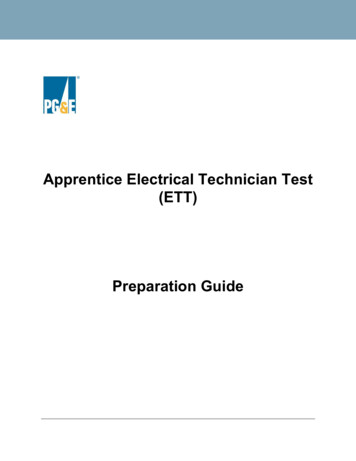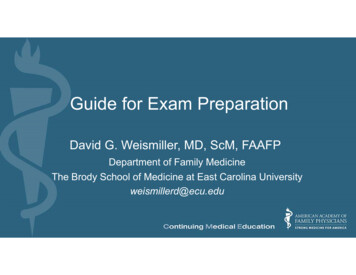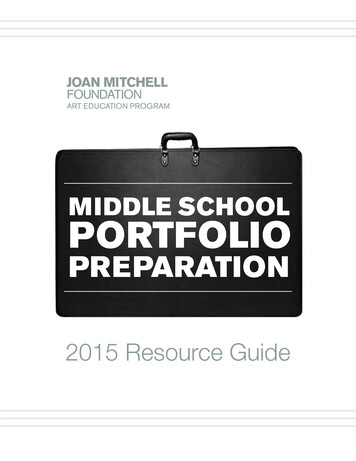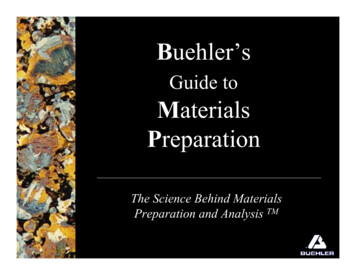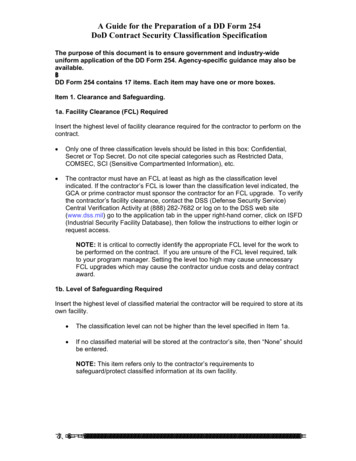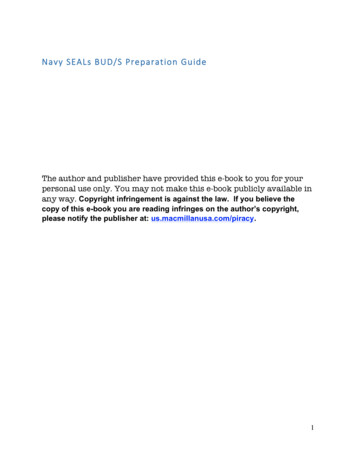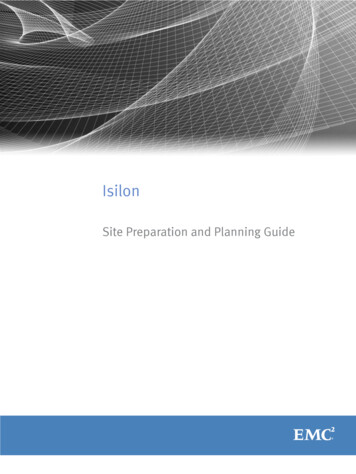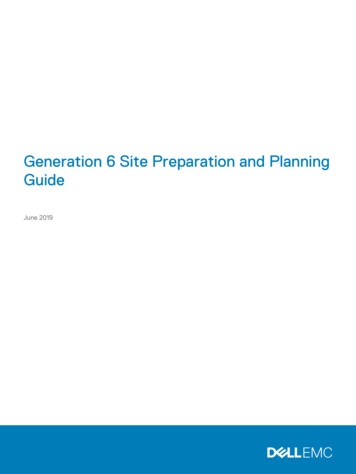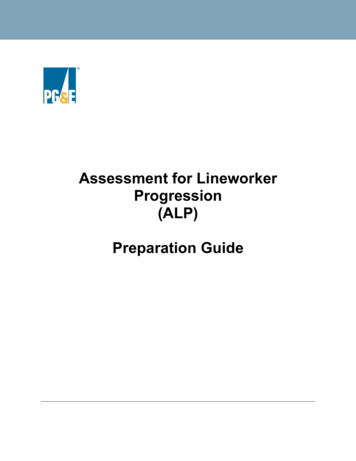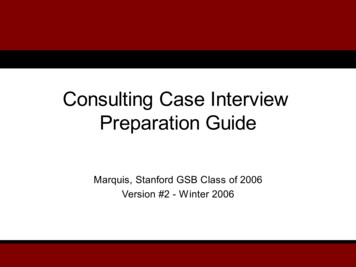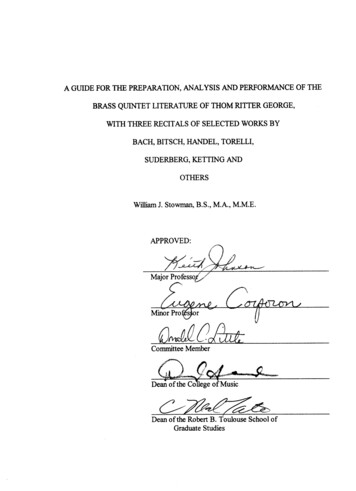
Transcription
A GUIDE FOR THE PREPARATION, ANALYSIS AND PERFORMANCE OF THEBRASS QUINTET LITERATURE OF THOM RITTER GEORGE,WITH THREE RECITALS OF SELECTED WORKS BYBACH, BITSCH, HANDEL, TORELLI,SUDERBERG, KETTING ANDOTHERSWilliam J. Stowman, B.S., M.A., M.M.E.APPROVED:Major ProfessopMinor Pros orCommittee MemberDean of the Co ege of MusicDean of the Robert B. Toulouse School ofGraduate Studies
A GUIDE FOR THE PREPARATION, ANALYSIS AND PERFORMANCE OF THEBRASS QUINTET LITERATURE OF THOM RITTER GEORGE,WITH THREE RECITALS OF SELECTED WORKS BYBACH, BITSCH, HANDEL, TORELLI,SUDERBERG, KETTINGAND OTHERSDISSERTATIONPresented to the Graduate Council of theUniversity of North Texas in PartialFulfillment of the RequirementsFor the Degree ofDOCTOR OF MUSICAL ARTSByWilliam J. Stowman, B.S., M.A., MME.Denton, TexasMay, 1998
Stowman, William J. A Guide for the Preparation. Analysis. and Performance of the BrassQuintet Literature of Thom Ritter George. Doctor of Musical Arts (Performance),May, 1998, 72 pp., 52 bibliography.An examination of the musical style, compositional techniques and performancepractice issues of American Composer Thom Ritter George with special attention paid tohis Quintet No. 4 written in 1986. The document also includes a short history of brassinstruments in chamber music, history of the brass quintet in America, discussion of therole of the trumpet in the quintet, overview of the composers contributions to music andbrass quintet, and background information on the composer.A detailed analysis of Quintet No. 4 is provided. Issues of performance practice arediscussed through theoretical analysis and in interviews with the composer.Thom Ritter George (b. 1942) received his Bachelors Degree and Master of MusicDegree at the Eastman School of Music and holds the Doctor of Musical Arts Degreefrom The Catholic University of America. He has served as composer and arranger forthe United States Navy Band in Washington, D.C. and as the Music Director andConductor of the Quincy, Illinois Symphony Orchestra. Currently, he is Music Directorand Conductor of the Idaho State Civic Symphony and Professor of Music at Idaho StateUniversity. He has written over 300 works ranging from simple songs to large symphoniccompositions. His interest in writing for brass instruments dates from the early 1960's, theperiod of his association with the great trombone teacher, Emory Remington.
Copyright byWilliam J. Stowman1998iii
TABLE OF CONTENTSpageRECITAL PROGRAMS.ACKNOWLEDGEMENTS. .vu.m.ChapterI.A BRIEF HISTORY OF THE BRASS QUINTET . .1Evolution of an ensembleDevelopment of a repertoireTranscriptionsCommissions and the repertoire's growthInstrumentationThe role of the trumpet in the brass quintetII.THE MUSIC OF THOM RITTER GEORGE. .The composer's background and personal historyPublication of the brass quintetsThe brass quintets: An overviewBrass Quintet No. IBrass Quintet No. 2Brass Quintet No. 3Brass Quintet No. 5Fanfare No. 7v.19
III.ANALYSIS OF QUINTET NO.4 . . . . . . . . . . . . . . . . . . . . 29Inception and history of the workCharacteristics of the Composers styleTheoretical analysis of Movement ISound and general musical characterMelodic elementsHarmonic elementsRhythmic elementsFormal considerationsPerformance practice issues revealed by analysisTheoretical analysis of Movement IISound and general musical characterMelodic elementsHarmonic elementsRhythmic elementsFormal considerationsPerformance practice issues revealed by analysisTheoretical analysis of Movement IIISound and general musical characterMelodic elementsHarmonic elementsRhythmic elementsFormal considerationsPerformance practice issues revealed by analysisTheoretical analysis of Movement IVSound and general musical characterMelodic elementsHarmonic elementsRhythmic elementsFormal considerationsPerformance practice issues revealed by analysisSummary and ConclusionsBIBLIOGRAPHY . . . . . . . . . . . . . . . . . . . . . . . . . . . .vi73
-University of North TexaspresentsA Graduate RecitalWILLIAM J. STOWMAN, trumpetaccompanied byGabriel SAnchez, pianoassisted byKurt Gorman, trumpet " Tom Brantley, tromboneJohn Rauschuber, horn - Richard Morgan, tubaMonday, June 19, 1995Concert Hall5:00 pmG. F. HandelSuite in D.OvertureGigueAir (Menuetto)March (Bourie)MarchGeorges EnescoLegend .Caprice .Joseph Turrin-- IntermissionJacques CastdrIde.Concertino .Allegro energicoAndante sostenuto-AllegroBelieve me, if all those endearing young charms.Presented in partial fulfillment of therequirements for the degree of- Doctor of Musical ArtsviiITraditionalarr. Stowman
University of North TexaspresentsA Graduate RecitalWILLIAM J. STOWMAN, trumpetassisted byBradley J. Genevro, clarinet - Steven R. Dube, trumpetNina Schumann, piano6:30 pmMonday, June 16, 1997IntradaRecital HallOtto Ketting.Robert SuderburgChamberMusic VII.1. calls and echoes, allegro2. calls and echoes, adagio, andante3. procession, closing-call-- IntermissionGiuseppe AdrovandiniSonata No. 2 .AllegroAdagioAllegroGiuseppe TorelliSinfonia con Tromba .AllegroAdagioAllegroAllegro non troppoDouble Concertofor Clarinetand Trumpet .AllegroLargoAllegro vivacePresented in partial fulfillment of therequirements for the degree ofDoctor of Musical ArtsviiiGordon Jacob
University of North TexaspresentsA Graduate RecitalWILLIAM J. STOWMAN, trumpetassisted byBradley J. Genevro, clarinet " Steven R. Dube, trumpetNina Schumann, piano6:30 pmMonday, June 16, 1997Recital HallOtto KettingIntrada .Robert SuderburgChamberMusic VII .1. calls and echoes, allegro2. calls and echoes, adagio, andante3. procession, closing-call-- IntermissionGiuseppe AdrovandiniSonata No. 2. .AllegroAdagioAllegroGiuseppe TorelliSinfonia con Tromba .AllegroAdagioAllegroAllegro non troppoDouble Concertofor Clarinetand Trumpet .AllegroLargoAllegro vivacePresented in partial fulfillment of therequirements for the degree ofDoctor of Musical ArtsixGordon Jacob
University of North TexasIFrpresentsA Graduate RecitalWILLIAM J. STOWMAN, trumpetaccompanied byGabriel Sanchez, pianoassisted byLarry Jones,trwnpet" Steven Dube, trumpetJemmiLou Rye, soprano " Masako Kikuchi, violinNorio Koizurm, violin " James H. Hammond, violaJeffrey A. Lang, 'cello e Wayne Foster, harpsichordJason Worzbyt, conductor5:00 pmMonday, March 4, 1996Benjamin BrittenFanfarefor St. Ednundsbury . .Sonata.".Concert HallThom Ritter GeorgeI. Ag HatoII. Adagio (Night Song)Vivace assai e ScherzandoIII.".".".".". . .". . . . .-#.". ". . . ". . ".".J. NerudaIntermission-.Concerto .I. AllegroII. LargoIII. VivaceCantata No. SI.No. IArieNo. 2No. 3No. 4RecitativArieChoralPresented in partial fulfillment of therequirements for the degree ofDoctor of Musical ArtsxJ. S.Bach
CHAPTER IA BRIEF HISTORY OF THE BRASS QUINTETEvolution of an EnsembleThe term brass quintet refers to a chamber ensemble of five players, usuallyconsisting of two trumpets, one horn, one trombone and a tuba or bass trombone. Manybelieve that the birth of the modem brass quintet occurred in 1954 with the inception ofthe New York Brass Quintet. ' This event was, however, foreshadowed by the beginningof the New York Brass Ensemble in 1947.2The existence of a brass chamber ensemble is not entirely a twentieth-centuryidea. While the modern brass quintet has emerged during the mid 1900's, other ensemblesand events throughout history serve as pre-cursors to the genre and provide a significantfoundation for more recent developments. Consorts of instruments have existed since atleast the Renaissance. 3 The research of David Whitwell proves the existence of small civicwind bands in Medieval Western Europe during the twelfth century. These musicianswere employed as watchmen who guarded the cities during the night against attack,' William Brown, "School Brass Quintets," Instrumentalist (August 1992): 67.2 WilliamJones, "The Brass Quintet: An Historical and Stylistic Survey" (D.M.A.diss., University of Kentucky), in progress.3 WilliamBrown, "School Brass Quintets," Instrumentalist (August 1992): 67.1
2predators, rogues and especially fire.4 Eventually, these musicians, referred to in Englandas "waits," took on other duties such as playing fanfares to announce the time duringdarkness and aubaudes to warn lovers of the impending sunrise.'These musicians were civic employees and played for various events such asbanquets, whippings, floggings and weddings.' By the fifteenth century, these groups hadevolved into ensembles consisting of shawms and slide trumpets or trombones. In additionto their performance of tower music, they played regular public concerts. These concertsrepresent the first real use of the word "concert" as well as the beginning of "art music."7Titles for these musicians vary with each country and language. Whether referred to ascarrocio, pifferi, trombetti, stadpppersor scalmeyers, these musicians provided thefoundation upon which modern brass ensembles were based.Another noteworthy stage in the evolution of the ensemble occurred during thefifteenth century at the hands of the aristocracy. This was a time of great enthusiasm forinstrumental music, especially wind music, and the courts provided many opportunities formusic-making.! The atmosphere of the court demanded an organized system of music.Clear distinction between different types of groups was necessary. The terms "haut"' David Whitwell,Winds, 1985), 23.s Ibid.6Ibid.7 Ibid.8Ibid., 31."A Concise History of the Wind Band," (Northridge, California:
3(loud) and "bas" (soft) were used to designate the type of ensemble required for eachparticular event. 9 Other references from the fifteenth century reveal the use of trumpet ortrombone choirs that were used for special occasions.' 0During the Renaissance, the concept of"haut" and "bas" was replaced by thenotion of consorts or families of instruments which allowed for a more homogenoussound." With the addition of lower voiced instruments, the ensembles acquired a darkersound now considered more pleasing than the characteristic bright sound of the Medievalgroups. Coincidentally, the families of instruments used in Renaissance consorts wereoften made by the same maker, therefore intonation was greatly improved.'2Thefollowing quotation illustrates the fervor with which the Renaissance noblemanapproached the idea of consorts.If you would have your kennels for sweetness of cry then you must compound itof some large dogs that have deep, solemn mouths. . .which must as it were bear thebass in consort, than a double number of roaring and loud-ringing mouths whichmust bear the counter tenor, then some hollow, plain, sweet mouths which must bearthe mean or middle part and so with these three parts of music you shall make yourcry perfect. (Whitwell, 1985, 50)After mid-century the notion of the broken consort began to appear. The practice ofmixing members from various consorts originated to compensate for inherent weaknessesin the groups. Whitwell points out that the trombone consort, which lacked a capable9 Ibid., 31.'D Ibid., 40." Ibid., 50.12Ibid.
4upper voice, and the cornet consort which lacked an adequate bass voice, were combinedto make one of the most popular broken consorts of the sixteenth century 13 . Extantliterature of civic wind bands during the sixteenth century provides examples of pieces,some of which required four or five players. 14The Baroque period offers further illustrations of the use of brass instrumentsgrouped together for performance. Perhaps the most noteworthy are the GermanStadtpfeifer's performance of Abblasen, chorales and hymns performed from civic orchurch towers. 5One famous Stadtpfeifer is Gottfried Reiche (1667-1734),16 who in thepreface of his collection of music for civic wind bands, relates the spiritual beauty andpower of this music." Another important figure from Leipzig is Johann Pezel (16391694)." Pezel provides an important link to the modern quintet in that several of hisworks, transcribed for the modern instruments, have become standard in the repertoire.The Renaissance and Baroque periods offer several treatises that influenced thedevelopment of instruments, music and performance practices. Michael Praetorius (15711621) and Daniel Speer (1636-1707) are two examples of authors who made significant13Ibid., 51"Ibid."Ibid., 142.16Edward Tarr, "The Trumpet," (Portland, Oregon: Amadeus Press: 1988), 105'7 Whitwell, 142.iSEdward Tarr, "The Trumpet," (Portland, Oregon: Amadeus Press: 1988), 105.
5contributions via treatises during this time. 19 The Syntagma Musicum of 1619 by MichaelPraetorius is often considered the most important treatise because of the information itcontains concerning instrumentation and performance practice. 2 0 The second half of theeighteenth century was focused on the development of the orchestra and on writing forsolo instruments as opposed to chamber groups. 2 1It is quite possible that the nineteenth-century's foremost contribution to thedevelopment of brass instruments has more to do with industry than music. In 1815, thevalve was invented allowing instruments to play chromatically. In 1844, Hector Berliozproduced an monumental treatise on orchestration and instruments titled Grandtraiced'instrumentationet d'orchestrationmodernes that provided great insight into thedevelopment and capabilities of the instruments being utilized. The Berlioz treatise isespecially helpful when discussing the
Otto Ketting Chamber Music VII. Robert Suderburg 1. calls and echoes, allegro 2. calls and echoes, adagio, andante 3. procession, closing-call - Intermission -Sonata No. 2 . Giuseppe Adrovandini Allegro Adagio Allegro Sinfonia con Tromba . Giuseppe Torelli Allegro Adagio Allegro Allegro non troppo Double Concerto for Clarinet and Trumpet . Gordon Jacob Allegro Largo Allegro .
